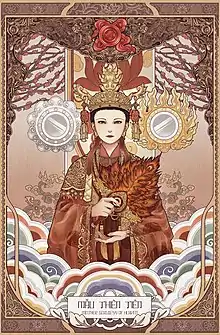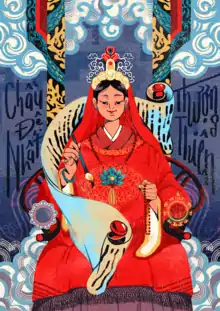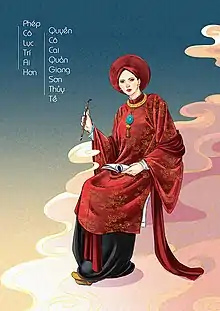Four Palaces
The Four Palaces (Tứ Phủ; Chữ Hán: 四府) is the most significant form of Đạo Mẫu, a worship of Mother Goddesses in Vietnam. This form is popular in the Northern and have a profound association with the worship of Đức Thánh Trần.
Its name literally means "Four Palaces" as its deities are believed to reside in four palaces, each of which serves as a ministry governing one realm of the universe.
There are four realms: Heaven, Mountains, Water and Earth. The palaces governing those realms are named as follow:
- Thiên phủ (Heaven Palace), ruled by Mother Goddess of Heaven (Mẫu Thượng Thiên)
- Nhạc phủ (Mountains Palace), ruled by Mother Goddess of Highlands (Mẫu Thượng Ngàn), also known as Mother Goddess of Forest Residence (Lâm Cung Thánh Mẫu)
- Thoải phủ (Water Palace) ruled by Mother Goddess of Water (Mẫu Thoải), also known as Mother Goddess of Water Residence (Thủy Cung Thánh Mẫu).
- Địa phủ (Earth Palace) ruled by Mother Goddess of Earth (Mẫu Địa Phủ), also known as Mother Goddess of Earth Residence (Lục Cung Thánh Mẫu).
The Pantheon of Four Palaces
The pantheon of Four Palaces includes the following ranks. While the hierarchy and names of the ranks are widely recognized and agreed upon, each rank might have some variations which include a different number of deities or a deity could have various stories and biographies. The belief is that a deity could manifest in various historic figures.
For the ranks with many variations, the first three or four figures are usually widely recognized and venerated, with the first position of Heaven, the second of High Mountains, the third of Water and the fourth as an Imperial Commissioner. The deities after the third or fourth position may have different names, titles and stories.
First Mother Goddess of Heaven (Mẫu Đệ Nhất Thượng Thiên)

The common short title is First Mother Goddess (Mẫu Đệ Nhất). Since she resides in the far-away Heaven Palace, it’s believed that she authorized Mother Goddess Liễu Hạnh, who is the Mother Goddess of Earth herself, to present her on Earth. Therefore, people are familiar with the concept of the Trinity of Mother Goddesses even though there are four Mother Goddesses of Four Palaces.
Third Mother Goddess of Water Palace (Mẫu Đệ Tam Thoải Phủ)
The common short title is Mother Goddess of Water (Mẫu Thoải).
Grand Mandarins (Quan Lớn)
This rank is usually referred to as the Five Honored Commanders (Ngũ Vị Tôn Quan). There is also another less common form of Ten Honored Commanders (Thập Vị Tôn Quan), where the multiple of the number 5 appears.[1]
First Grand Mandarin of Heaven (Quan Lớn Đệ Nhất Thượng Thiên)
His full title is the First Crown Prince and Princely Mandarin of Heaven (Đệ Nhất Thượng Thiên Hoàng Thái Tử Vương Quan)
Second Grand Mandarin of Mountainous Forests, the Supervisor (Quan Lớn Đệ Nhị Thượng Ngàn Giám Sát)
His full title is the Second Supervising Mandarin of Mountains (Đệ Nhị Thượng Ngàn Giám Sát). His other common title is the Supervising Mandarin (Quan Giám Sát).
Third Grand Mandarin of Water Palace (Quan Lớn Đệ Tam Thoải Phủ)
His full title is the Third Crown Prince and Princely Mandarin of Watery Palace (Đệ Tam Thoải Phủ Hoàng Thái Tử Vương Quan).
Fourth Grand Mandarin, the Imperial Commissioner (Quan Lớn Đệ Tứ Khâm Sai)
His full title is the Fourth Imperial Commissioner of the Four Palaces (Đệ Tứ Khâm Sai Quyền Cai Tứ Phủ). His other common title is the Imperial Commissioner Mandarin (Quan Khâm Sai).
Fifth Grand Mandarin of Tuần Tranh (Quan Lớn Đệ Ngũ Tuần Tranh)
His full title is The Fifth Grand Mandarin of Tranh River, the Inspector (Quan Lớn Đệ Ngũ Tuần Tranh)
Holy Courtier (Thánh Chầu)
Most of the devotees of Four Palaces refer to this rank as the Twelve Court Dames.
First Courtier of Heaven (Chầu Bà Đệ Nhất Thượng Thiên)

Second Courtier of Mountainous Forests (Chầu Đệ Nhị Thượng Ngàn)

Holy Princes (Thánh Hoàng)
This rank is usually referred to as the Ten of Princes.
Holy Mistresses (Thánh Cô)
It is widely recognized that there are twelve Mistresses in this rank. Similar to the rank of Court Dames, other Mistresses from various towns are also considered to belong to this rank.
First Mistress of Heaven (Cô Đệ Nhất Thượng Thiên)

Fourth Mistress of Earth Palace (Cô Tư Địa Phủ)
Some people believe that the Fourth Mistress of Earth Palace is worshipped at the Ỷ La Shrine, thus the title the Fourth Mistress of Ỷ La. However, some others believe that the Fourth Mistress of Ỷ La is among the Twelve Goddesses of Mountains Village.
Another title of the Fourth Mistress of Earth Palace is the Fourth Mistress of West Lake's Four Villages (Cô Tư Tứ Tổng Tây Hồ).
Note: She is not the same with the Fourth Mistress of Ỷ La who is one of the twelve Fairies of Mountains and Forests.
Little Mistresses of Mointains and Forests (Cô Bé Thượng Ngàn)
Each region usually has its own young female deity/deities. These young goddesses are believed to follow the Mother Goddess of Mountains and Forests in the Mountains Palace. They are the "Local Mistresses". One would be named "The Little Mistress of [name of the region]".
Little Mistress of Water
Holy Masters (Thánh Cậu)
Little is known about the rank of the Holy Masters. They are usually young squires who attend on the Princes.
The popular Masters include:
Second Master
He is believed to reside in Mount Sòng, Phố Cát, Ngang Hill.
Third Master
He attends on the Father Emperor of Water Palace, Mother Goddess of Water Palace or Third Prince of Water.
Fourth Master
He attends on the Fourth Grand Mandarin or the Fourth Courtier, both are the Imperial Commissioners
Little Master of Ngang Hill
He was a son to Mother Goddess Liễu Hạnh in her third incarnation
Local Masters
Each shrine might have its own Young Master.
References
- Ngô, Đức-Thịnh (2009). Đạo Mẫu Việt Nam. Book 1. Vietnam: Nhà xuất bản Tôn Giáo. p. 65.